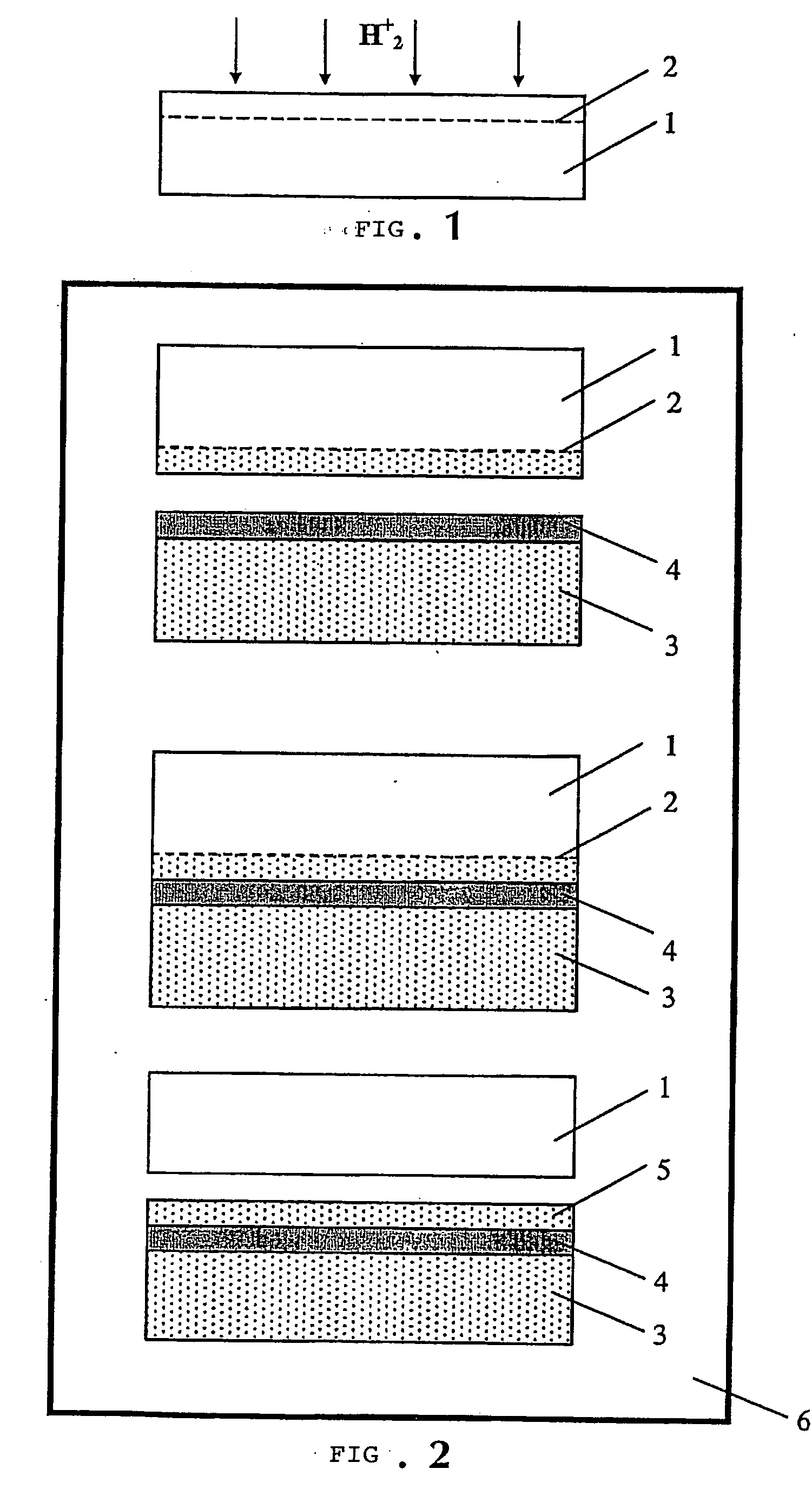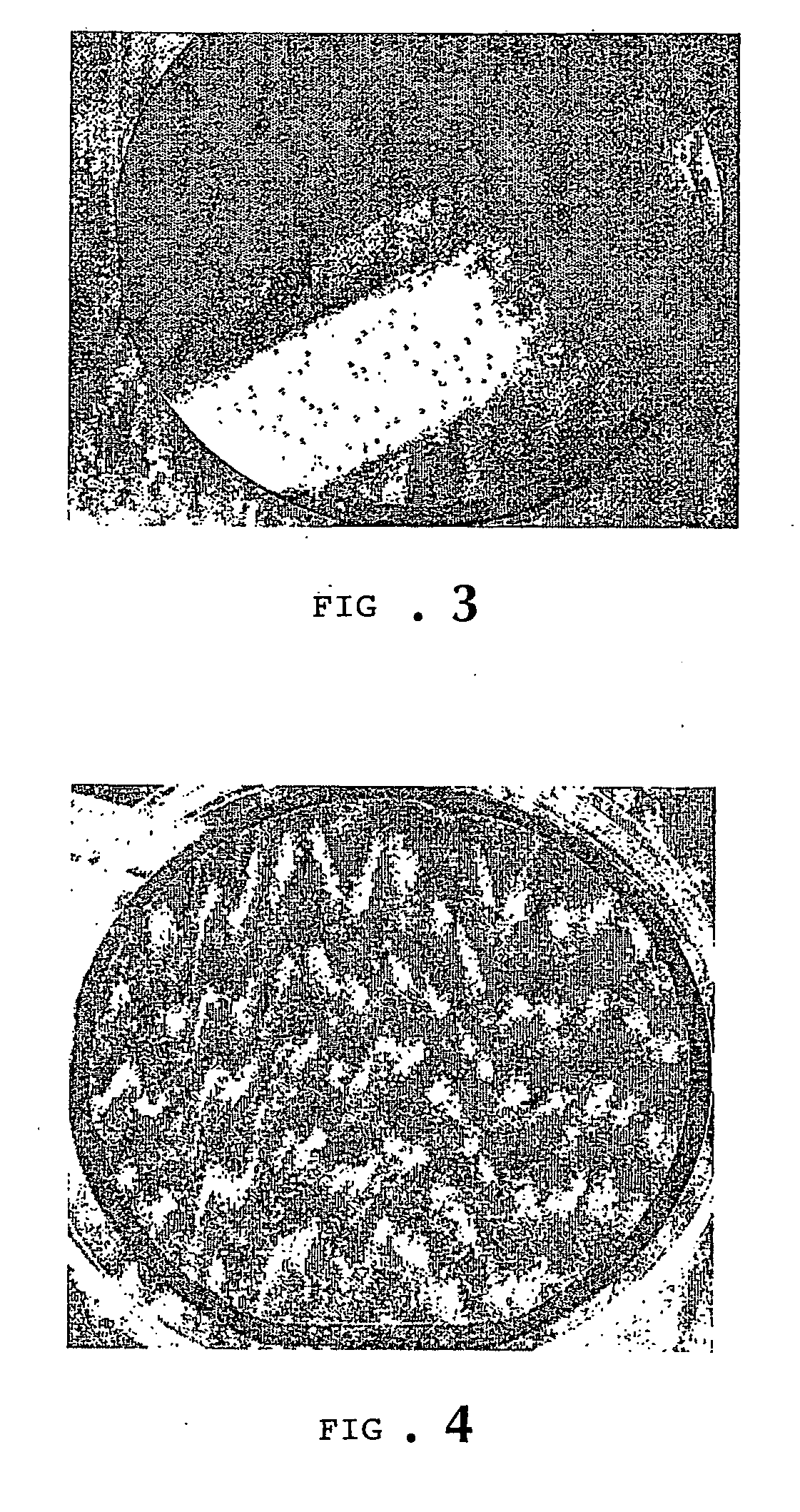Method for producing a silicon-on-insulator structure
a technology of silicon-on-insulator and structure, which is applied in the field of semiconductor/solid-state device manufacturing, electrical equipment, basic electric elements, etc., can solve the problems of low quality of buried oxide in soi structure, high straggling, and reduced production quality of silicon-on-insulator structur
- Summary
- Abstract
- Description
- Claims
- Application Information
AI Technical Summary
Benefits of technology
Problems solved by technology
Method used
Image
Examples
example 1
[0044] 1. H2+ ion implantation is carried out in silicon wafer with ion energy 140 keV and dose 2,5×1016 crm2 through thin 50 nm SiO2 layer, which prevents the surface contamination and following it is removed. [0045] 2. Silicon wafer with grown thermal oxide SiO2 (280 nm) is used as a substrate. [0046] 3. Chemical treatment of implanted silicon wafer and substrate is carried out including cleaning with deionized water stream douche or ultrasonic deionized water stream and hydrophilisation of surfaces of implanted wafer and unimplanted substrate, using treatment in the peroxide-acid and ammonia-peroxide solutions with following cleaning by water stream douche or ultrasonic deionized water stream. [0047] 4. H2+ implanted silicon wafer and silicon wafer with grown thermal oxide are placed in low vacuum chamber with pressure 102 Pa and heated to the temperature 300° C., dried and cleaned from the physically adsorbed substances during 0.1 hour and then joined together, spliced and exfol...
example 2
[0049] 1. H2+ ion implantation is carried out in silicon wafer with ion energy 40 keV and dose 1,5×1016 cm−2 through thin 5 nm SiO2 layer, which prevents the surface contamination and following it is removed. [0050] 2. Silicon wafer with grown thermal oxide SiO2 (280 nm) is used as a substrate. [0051] 3. Chemical treatment of implanted silicon wafer and substrate is carried out including cleaning with deionized water stream douche or ultrasonic deionized water stream and hydrophilisation of surfaces of implanted wafer and unimplanted substrate, using treatment in the RCA and ammonia-peroxide solutions with following cleaning by water stream douche or ultrasonic deionized water stream. [0052] 4. H2+ ion implanted silicon wafer and silicon wafer with grown thermal oxide are placed in low vacuum chamber with pressure 101 Pa and heated to the temperature 200° C., dried and cleaned from the physically adsorbed substances during 0.15 hour, then joined together and heated to 300° C., splic...
example 3
[0054] 1. H2+ ion implantation is carried out in silicon wafer with ion energy 140 keV and dose 5×1016 cm−2 through thin 50 nm SiO2 layer, which prevents the surface contamination and following it is removed. [0055] 2. Silicon wafer with grown thermal oxide SiO2 with the thickness 280 nm is used as a substrate. [0056] 3. Chemical treatment of implanted silicon wafer and substrate is carried out including cleaning with deionized water stream douche or ultrasonic deionized water stream and hydrophilisation of surfaces of implanted wafer and unimplanted substrate, using treatment in the RCA and ammonia-peroxide solutions with following cleaning by water stream douche or ultrasonic deionized water stream. [0057] 4. H2+ ion implanted silicon wafer and silicon wafer with grown thermal oxide are placed in low vacuum chamber with pressure 102 Pa and heated to the temperature 150° C., dried and cleaned from the physically adsorbed substances during 0.2 hour, then joined together and heated t...
PUM
| Property | Measurement | Unit |
|---|---|---|
| thickness | aaaaa | aaaaa |
| thickness | aaaaa | aaaaa |
| thickness | aaaaa | aaaaa |
Abstract
Description
Claims
Application Information
 Login to View More
Login to View More - R&D
- Intellectual Property
- Life Sciences
- Materials
- Tech Scout
- Unparalleled Data Quality
- Higher Quality Content
- 60% Fewer Hallucinations
Browse by: Latest US Patents, China's latest patents, Technical Efficacy Thesaurus, Application Domain, Technology Topic, Popular Technical Reports.
© 2025 PatSnap. All rights reserved.Legal|Privacy policy|Modern Slavery Act Transparency Statement|Sitemap|About US| Contact US: help@patsnap.com



